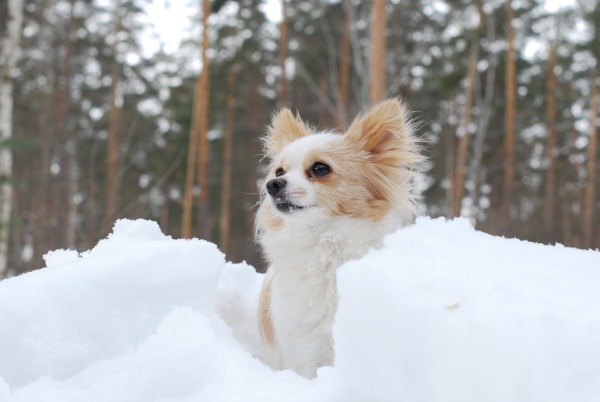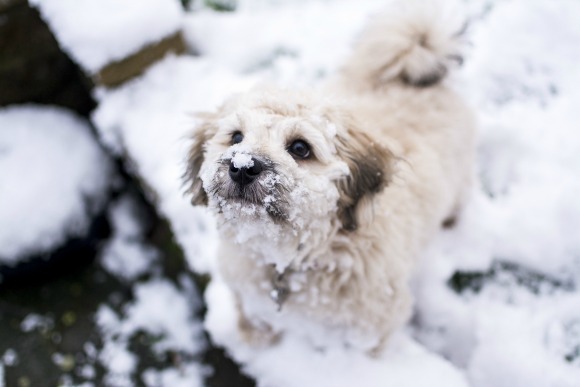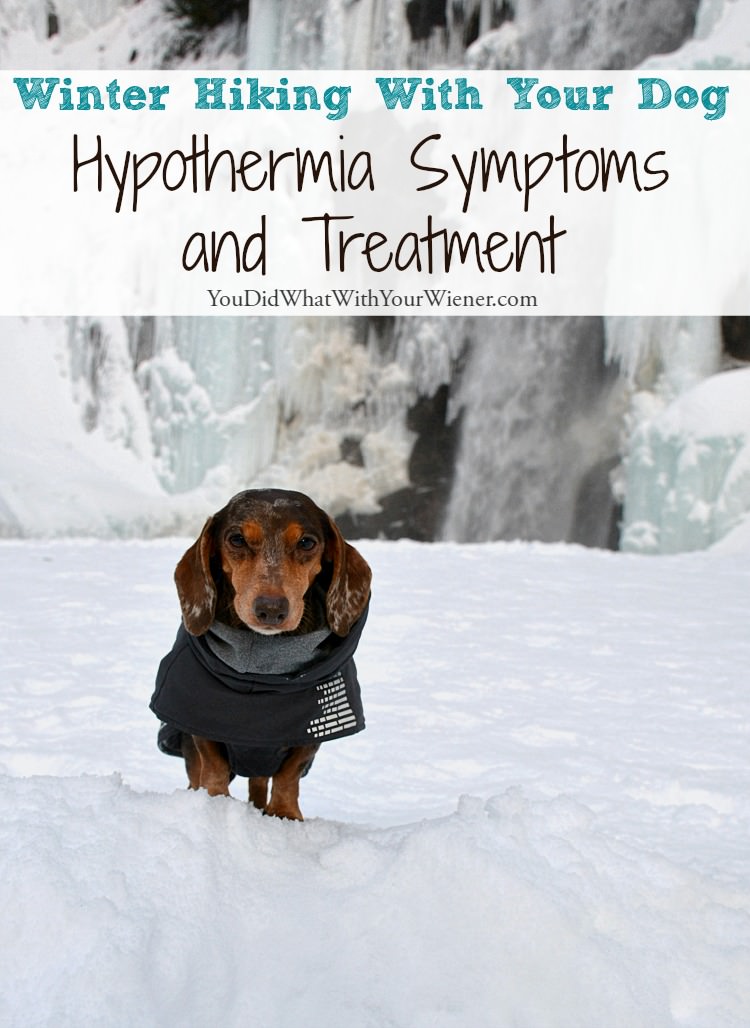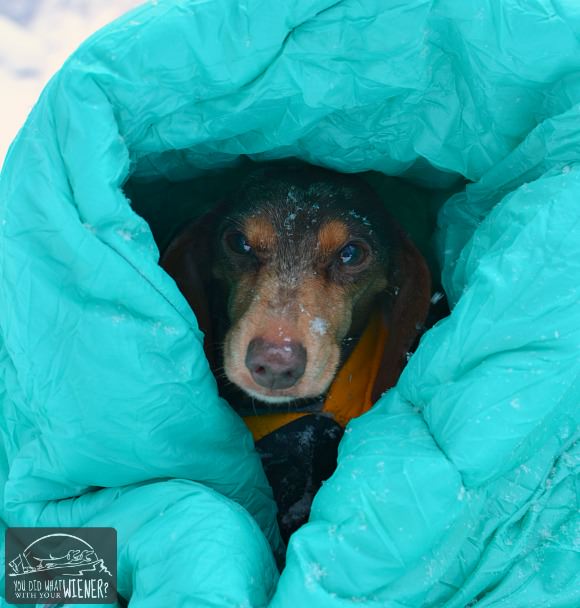Hiking With Your Dog This Winter? Beware of Hypothermia
I hike and walk with my small dogs in the snow all Winter.
My Dachsunds Summit and Gretel venture out in colder temperatures than most small dogs do. Or, at least, they are outside in cold temperatures longer than most dogs.
Our average, our winter hikes is in snow are 3-4 hours long and the air temperature is 20-35o F degrees.
I’ve never had a serious problem with my small dogs in the many years we’ve been braving the elements.
However, I would be lying if I said they never got cold.

When we’re moving on the trail, they seem oblivious to the cold. They have jackets on and their body stays warm from the movement.
Because of the way a dog’s feet work, their paws stay pretty warm too.
As soon as we stop though, they start to cool off. They’ll start to shiver a bit right away.
Honestly, I don’t think a little shivering is a big deal. In my experience, all small, short-coated dogs shiver when the air is crisp.
I think, like me, their skin is conditioned to the warmth of our house so even a slight cold breeze will give them the chills.
It’s not dangerous or torturous for them. It’s just a natural physical reaction.
However, there is a possibility that they could get too cold.
If they do, they could get hypothermia… which is dangerous.
It’s something I watch for closely.
What is Hypothermia in Dogs?
According to PetMD,
“Hypothermia is a medical condition that is characterized by an abnormally low body temperature. It has three phases: mild, moderate, and severe.
Hypothermia occurs when an animal’s body is no longer able to maintain normal temperature, causing a depression of the central nervous system (CNS).
It may also affect heart and blood flow (cardiovascular), breathing (respiratory), and the immune system. An irregular heartbeat, trouble breathing, and impaired consciousness to the point of coma may result.”
Sounds super scary, right? It is. Hypothermia is no joke. And small dogs are more susceptible to getting it than larger dogs because it’s harder for them to generate their own body heat.
WARNING: I AM NOT A VETERINARIAN. WHAT I’M SHARING HERE IS BASED SOLELY ON MY RESEARCH, MY EXPERIENCE AND WHAT I LEARNED ABOUT HYPOTHERMIA IN MY PET FIRST AID CLASS.
Important: 6 Reasons You Should Get Certified in Pet First Aid
Sigs and Symptoms of Hypothermia in Dogs
You may be wondering, How Do I Know If My Dog Has Hypothermia?
As long as you are aware hypothermia is a possibility, and watch for the early warning signs, you will know when it’s too cold and you should call it a day.
Frankly, knowing how to spot the signs something is wrong starts in the comfort of your own home.
- You should have a basic idea of how many breaths your dog takes a minute.
- You should also know where to find their pulse (hint: the groin area – take a class or find pictures online if you don’t already know) and what normal is for them.
Once you know those things, you’ll have a baseline to compare things to when out hiking.
Signs and symptoms of hypothermia you’ll be able to see, and feel, when you’re out hiking are:
Mild hypothermia:
- faster breathing
- rapid heart rate
- cold to the touch
- weakness
- moderate shivering
- lack of mental alertness
Moderate hypothermia:
- violent shivering
- slowed heart rate (weak pulse)
- shallow, slow breathing
- muscle stiffness
- trouble walking
- gums and inner eyelids are pale or blue
Severe hypothermia:
You should never get here but I’m listing the symptoms just in case.
- shivering stops
- fixed and dilated pupils
- inaudible heartbeat
- difficulty breathing
- walking is almost impossible
- coma
Mitigating the Risks of Hypothermia
Note: This article contains affiliate links, which means I get a few pennies to help support this blog, at no extra cost to you, if you make a purchase (and we really, really appreciate it!)
It may not seem like it, but going out in the cold is always risky – both for humans and pets. Heck, living is risky.
The key to a happy, healthy life is mitigating the risks.
It’s no different with hypothermia. Just know the risk, know what the signs are, pay keen attention to your dog, and have a game plan that stars before you even leave the house.
Know how you plan to mitigate the risks for them and what you will do if your dog starts showing signs of hypothermia.
This is what I do to protect my small dogs for hypothermia in the winter.
This helps prevent hypothermia in the first place and can act as a treatment if they start to show mild signs.
Put a warm jacket on them
Bundle them up in a super warm jacket – one that will keep their body core temperature warmer than they would be sitting around at home.
Dress Them in Layers
Just like with people clothes, layering dog clothes can be key to corectly regulating your dog’s body temperature.
I bring an extra thin jacket (like one from Teckelklub) for layering in case the dog jacket I brought is not warm enough.
Regularly check them both visually and by feeling them
I feel under their coat to make sure their body is toasty warm.
Keeping their core body temperature warm is important.
I also feel their ears, legs, feet, and tail to make sure they don’t feel too cold or stiff or that there is no pain when I touch them (all signs of frostbite).
Bring something for them to stand on when we stop
This one is more relevant for small dogs and senior dogs because their feet can become more sensitive.
I Bring blankets for my dogs to sit in when we stop and rest.
If it’s really cold, I bring a small foam pad to place under it for extra insulation.
Bring an aire-activated body warmer
I bring one of those air-activated body warmers to put inside of the blankets if we are taking a long break and they show signs of getting cold.
The ones I get are self-stick so I can also stick them to the outside back of a thin fleece jacket.
I put that on and then put their regular jacket on top of it.
I rarely use the warmers but I like to have one or two in case they get too cold and I need to slowly warm their body.
Bring a warm drink
I bring a warm drink for them in an insulated Hydroflask bottle.
Just like I appreciate a cup of hot cocoa on a cold day to warm my belly, my dogs appreciate a warm drink too.
I either bring warm Honest Kitchen Bone Broth or Honest Kitchen Instant Goat Milk (for a real treat, I add a teaspoon of plain, pureed pumpkin and a dash of cinnamon to it).
What Do I Do If I Think My Dog Has Hypothermia?
Accidents do happen.
What if your dog starts showing signs of hypothermia? What can you do?

Like I said, I can see my small dogs shivering several times when out on our snowy hikes.
Mild shivering, or trembling, is not a big deal. It usually stops once they get hiking again.
I’ve been known to slowly walk them in circles on our breaks to prevent them from cooling down too much.
If the break will be long, I get out the blankets for them to snuggle in.
Sometimes I think it’s too cold for them and insist that they go into the blankets. They insist that they don’t want too. Fair enough.
I just make sure they know they have the option and let them make their own decisions while still keeping a watchful eye on them.
If they started to show symptoms of hypothermia though, the first thing I would do is to add that second thin jacket or any extra layers I brought.
The second thing I would do is pack up and head back to the car.
According to my Walks N’ Wags Pet First Aid Manual, these are ways you can start to treat your dog’s hypothermia before you get back to the car.
- Minimize their movement to conserve body heat
- Prevent further heat loss by moving the animal to shelter
- If the pet is wet, dry them as best as possible
- Warm them using blankets, heat pads (like the body warmers I suggested bringing), or your own body heat
- If your pet is conscious, give it a warm liquid to drink (like the warm drink in the insulated bottle I suggested – bonus if it has sugars in it)
The nice thing about small dogs is that they can be carried so I would do these things while I was carrying them out.
They should start warming up on the way out, and even more once you get back to the car and can turn the heater on.
Still, you should head to the nearest veterinarian to seek medical treatment.
For severe hypothermia, invasive core warming will be necessary, such as the administration of warm water enemas and warm intravenous (IV) fluids.
Further essential treatments, especially for severe hypothermia, include breathing aids, such as oxygen, which may be administered with a face mask, and IV fluids for blood volume support.
Final Thoughts
Hypotermia in dogs is a scary, and potentially deadly, condition.
You can help keep your dog safe and happy when hiking or walking in winter by:
- Being prepared by taking steps to prevent it
- Knowing what to do if your dog starts to show hyperthermia signs and symptoms
- Knowing how to start treating hypothermia when you can’t gt to the veterinarian right away
Being prepared to prevent and address hypotermia in your dog while on the trail means that you need to carry some extra items with you in your pack.
Have you seen the size of my backpack?
Some people laugh when they see me go for a day hike and ask if I am staying the night but I will do anything to keep my small dogs warm and safe so it’s worth it.
In addition to the items I listed previously in the article, I always carry my Garmin InReach Explorer Satellite Communicator that has an emergency locator function (press a button to sent coordinates to 911/search and rescue) and allows me to text my friends and family when there is no cell service.
It’s an expensive item but one I won’t go without now.
Although I would do everything I can to protect myself and my dogs so I don’t have to use it, I could if it was a life-threatening emergency.
We are very fortunate here in Washington State that we have a search and rescue team solely dedicated to saving animals called the Washington State Animal Response Team.
Stay safe out there my friends!


About the Author
Hi, I’m Jessica. I’ve been studying the Dachshund breed since 2007, owned 3 of my own, and shared in the lives of thousands of others through their owner’s stories. When I’m not sharing what I know on this blog, you can find me hiking, camping, and traveling with my adventurous wiener dogs.


A pawsome comprehensive article on hypothermia.
Thank you for writing about this very serious condition.
Nose nudges,
CEO Olivia
One of the recurring themes in winter hiking conversations in my area (where we average one or two hiker deaths a year due to exposure and hypothermia) is the need to plan for what happens if you get injured or otherwise pinned down out there. Very smart to bring the blankets! The recommendations in our area (where it does get colder, so of course mileage varies) include a sleeping bag and some form of emergency shelter. I’m looking at adding an ultralight four-season tent since I have two big dogs, but there are some nice, inexpensive, lightweight emergency bivy bags that could be (have been) game-changers in an emergency.
The trails we hike around Seattle see a lot of people on them. If I was injured, there would be someone along shortly to help me out. Also, this article was written to address the dogs, not what would happen to a person if they were injured or hypothermic. However, I appreciate you pointing these things out. Since I have people’s attention with the article, I thought it was a good idea to add a “PSA” about this… so thanks for mentioning it! Stay safe out there 🙂
Great post! It’s so important to recognize the signs of hypothermia! We had a mild scare back in the spring with Phoenix from swimming in the cold river! Luckily we recognized what was happening and we were able to get her warmed up. She ended up being fine but I won’t ever let her swim again until Summer time.
I remember that! How scary. I’m not sure I would have thought of that. Then again, my dogs don’t like being in the water 🙂 Glad everything turned out ok.
Great post! We’re moving this spring;/summer and having this info will come in handy.
How exciting! Where are you moving to? Since this “info will come in handy”, I’m thinking someplace cold?
This is a subject that I needed to read about. We do get some crisp temps here, but they never last long. My dogs and I have never hiked in snow, or somewhere where the temps remain in the range you mentioned for very long. It is my intention to do some cold weather hiking in the future so this is info that is very useful for me to know and I don’t think many folks think about it. Thanks for sharing this info!
We just spent the weekend in a mountain town and it was 10-15 degrees during the day. Chester and Gretel did ok for at least 10 minutes…. longer if it was closer to 10 degrees and shorter if it was closer to 5). But then one or both dogs would stop walking and hold up their paw. I think you saw my post about dog boots. They definitely could have used some there (wouldn’t want frostbite). If they were moving though, I don’t think I would have worried about hypothermia. I’m glad to know the signs though and what to do. The condition is sneaky and it can happen when you least expect it. It doesn’t always happen at the coldest temperatures. I’ve seen cases where a person got hypothermia with it was 40 degrees.